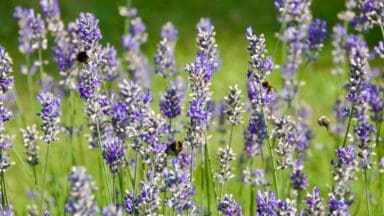
On publication of the updated Plants for Pollinators list, the Royal Horticultural Society (RHS) emphasises the urgent need for a greater quantity of drought-resistant summer flowering garden plants to support pollinators.
The warm and dry weather has been good for pollinators, but this year’s lack of rainfall has resulted in many summer flowering favourites, such as oxeye daisy, rudbeckia, and phlox, reaching only approximately half their average size. Consequently, the number of blooms has decreased or has rapidly faded due to the heat. This has affected plants’ nectar provision, making it more crucial than ever to have a diverse range of flowers that thrive in dry conditions.
In addition to known drought-tolerant plants such as salvia and lavender, the charity also recommends sea holly, euphorbia, helianthus, and marjoram in its review of the Plants for Pollinators list. Initially launched in 2011, this list identifies plants that gardeners can cultivate to support the UK’s 6,000 pollinating insects. The 2025 updated list now encompasses nearly 10,000 plants, representing approximately 15% of all plants available for purchase in the UK. This includes 19 recently elevated to genus level, such as Eryngium, Origanum, Lavandula, Prunus, Euphorbia, and Campanula.
“Indications are that the warm and dry conditions in the first half of the year have been good for pollinators. But should rainfall remain low as we head into late summer then plants’ growth potential and provision of nectar will continue to be impacted by the lack of water so gardeners should look to drought resistant favourites to outlast these periods and future proof their gardens. Using our updated pollinator list to determine which are best for the conditions in your garden and on a local level is so important if we’re to help reverse the decline in UK pollinator numbers. We wouldn’t be surprised to see the likes of marjoram and sea holly becoming more popular with gardeners owing to their structure, resilience and pollinator appeal,” explained Andrew Salisbury, entomologist and Head of Plant Health at the RHS.
The RHS adds that 14 plants have been removed from the list as a result of a new methodology that incorporates literature reviews and working group observations. Though they may still provide summer appeal, more drought tolerant varieties are recommended. Those removed include Cleome hassleriana, Cuphea ignea, Catananche caerulea and Amberboa moschata.
Aiming to combat pollinator decline, the Plants for Pollinators list includes plants that attract a variety of pollinators, including butterflies, hoverflies, wasps, moths, and bees. The list categorises plants into cultivated garden plants and wildflowers. Each plant must be suitable for gardens, have high nectar, pollen, or oil content, or be an important pollinator resource in autumn and winter. Prolific bloom, attracting multiple insect groups, or serving as a valuable resource for pollinators are also considered. A new methodology combining literature reviews and observations will assess potential new additions to the list. The review is part of the RHS Plants for Purpose project, which recommends plants suitable in responding to local geography and climactic and environmental conditions such as flooding and drought and pollution.
The list of plants that feature on Plants for Pollinators is searchable on the RHS website and denoted in garden centres by those bearing the logo.

